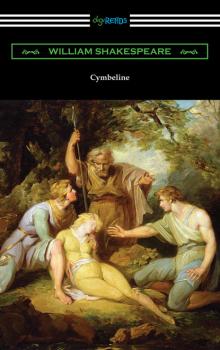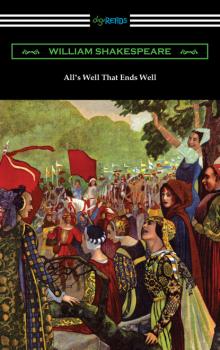William Shakespeare
Список книг автора William ShakespeareAs You Like It
"As You Like It", is one of William Shakespeare's most loved and often performed romantic comedies. «As You Like It» is the story of a Duke, who when unjustly deposed by his younger brother, Frederick, flees to the forest of Arden. The Duke's daughter, Rosalind, remains at the court until it is discovered that she has fallen in love with Orlando, the son of the Duke's friend. Rosalind flees with her cousin Celia in the guise of two young men to the forest of Arden so that she may pursue Orlando. There she meets a host of interesting characters and when her true identity is revealed love and happiness is finally achieved.
The Two Gentleman of Verona
“The Two Gentlemen of Verona” is one of the Shakespeare’s classic romantic plays and considered by some scholars to possibly be the playwright’s first play. It is the story of two young gentlemen from Verona, Valentine and Proteus, who travel to Milan so that they may learn to be “perfect gentlemen”. Valentine is eager to begin this new adventure, but Proteus is reluctant to go as he has fallen in love with the beautiful Julia and she returns his devotion. However, Proteus’s father forces him to leave and he pledges his love to Julia before they part. In Milan, both Valentine and Proteus fall in love with the Duke’s daughter, Silvia, and Proteus is quick to forget Julia. She has not forgotten about Proteus and disguises herself as a boy so that she may follow him to Milan. Silvia does not return Proteus’s regard and has herself fallen in love with Valentine, though her father does not approve of the match. Much confusion and comical misadventures ensue before each of the gentlemen end up with the right lady and all misunderstandings are resolved. This enduring classic by the Bard is a tale of love, romance, happy endings, and the importance of friendship. This edition is annotated by Henry N. Hudson, includes an introduction by Charles Harold Herford, and a biographical afterword.
Troilus and Cressida
Although one of his lesser known plays, Shakespeare’s considerable abilities as a playwright are readily apparent in “Troilus and Cressida.” This historical and tragic ‘problem play’, thought to be inspired by Chaucer, Homer, and some of Shakespeare’s history-recording contemporaries, is initially a tale of a man and woman in love during the Trojan War. When Cressida is given to the Greeks in exchange for a prisoner of war, Troilus is determined to rescue her. When he does find her, however, Troilus believes Cressida has betrayed him. On a larger scale, this play also deals with the political battle being waged by Agamemnon of the Greeks against Priam of the Trojans. Much of the plot centers on war councils and battles in which Hector and Achilles play a part. Ultimately, Shakespeare’s play is memorable for its love and betrayal, questioning of hierarchy and honor, morality in the face of reality, and cynical disillusionment. This edition is annotated by Henry N. Hudson, includes an introduction by Charles Harold Herford, and a biographical afterword.
The Merry Wives of Windsor
One of Shakespeare’s early comedies, “The Merry Wives of Windsor” was first published in 1602 and is believed to have been written sometime before 1597. It is unique among his plays for its exclusive focus on the middle class of Elizabethan England, though it is nominally set during the reign of Henry IV. The main character is a fat knight, Sir John Falstaff, who first appeared in Shakespeare’s plays “Henry IV, Part I” and “Henry IV, Part II.” Falstaff tries to woo two married women for money, but they quickly discover his scheming and trick him numerous times in return, creating memorable, humorous scenes at Falstaff’s expense. An additional thread is woven into the story concerning the daughter of one of the wives, who loves a man of whom her parents do not approve. Most likely written at the personal request of Queen Elizabeth for a court occasion, this cast of strong female characters fills the stage with spirited action, not always without irony, and creates a plot overlaid with such timeless themes as marriage, cuckoldry, wealth, social class, and love. This edition is annotated by Henry N. Hudson, includes an introduction by Charles Harold Herford, and a biographical afterword.
Henry IV, Part II
The third part of Shakespeare’s impressive “Henriad”, this play follows “Richard II” and “Henry IV, Part I”, and precedes the final play of the tetralogy, “Henry V”. Following the events of “Henry IV, Part I”, Prince Hal is once again out of favor with his father, the king, who is in his last months of life. In contrast to their relationship in “Part I”, Falstaff, the comical criminal, is rejected by Prince Hal. Falstaff and Prince Hal only share two brief scenes together as Hal believes he must disassociate himself with the London criminal underworld before becoming king. A more somber play than “Part I”, King Henry IV lies in bed, sick, dying, and beset by constant rebellion. He feels the weight of his role and wonders if Hal is equal to the task, reflecting in the famous quote “Uneasy lies the head that wears a crown.” Falstaff too, in moments of cynical clarity, reflects on his own poor health and approaching death. A central theme is Hal’s reform into a man worthy enough to be king in contrast with Falstaff’s continued dissolute life. “Henry IV, Part II” is a work of transformation, reconciliation, and musings on life and death that attest to the universal nature of Shakespeare’s dramas. This edition is annotated by Henry N. Hudson, includes an introduction by Charles Harold Herford, and a biographical afterword.
Cymbeline
Performed as early as 1611 and published in the “First Folio” in 1623, Shakespeare’s “Cymbeline” weaves an elaborate tale of palatial envy and power in Ancient Britain. Cymbeline, King of Britain, commands that his lovely young daughter Imogen marry Cloten, the violent and callous son of the current Queen by her former husband. With her heart already promised to the poor yet heroic Posthumus, Imogen refuses. Disgusted at the prospect of his daughter marrying beneath her class and thus unable to produce a worthy heir to the British throne, Cymbeline banishes Posthumus from Britain. The Queen becomes involved as well and plots the death of young Imogen and her father, the King, so that her son can rule. Against the backdrop of plots, treachery, a fairy-tale turn of events, and the appearance of a Roman god, Imogen and Posthumus travel long distances and overcome great odds in an attempt to be reunited. In the process, Imogen’s long-lost brothers are found, a Roman army is defeated, and the treacherous Queen is exposed. Exciting, tragic, romantic and adventurous, Shakespeare’s “Cymbeline” remains a thrilling and timeless depiction of young love. This edition is annotated by Henry N. Hudson, includes an introduction by Charles Harold Herford, and a biographical afterword.
All's Well That Ends Well
Originally published in Shakespeare’s “First Folio” in 1623, “All’s Well That Ends Well” is a fascinating play that defies classification, an unusual work that blends the comic with the tragic. The play tells the story of Helena, a penniless worker at the Palace of Rousillion, and her cunning adventures to wed Bertram, the prosperous son of the count. Bertram goes to Paris to attend the King of France and Helena follows and uses her cunning and charm to convince the King she is a healer. When Helena risks her life to rid the King of France of a peculiar illness, she is rewarded with her choice of grooms from the King’s court and she chooses the hand of Bertram. Faced with rejection from Bertram due to her lowly social status, she devises a clever and devious plan to birth his son and keep his ring. This is love as war, full of scheming, seduction, and manipulation. Based on a tale from Boccaccio’s, “The Decameron”, the play energizes a classic Shakespearean theme of love complicated and conflicted by differences in class. Full of the expected wit and ardor of Shakespeare, “All’s Well That Ends Well” is an entertaining classic. This edition is annotated by Henry N. Hudson, includes an introduction by Charles Harold Herford, and a biographical afterword.
Love's Labour's Lost (Annotated by Henry N. Hudson with an Introduction by Charles Harold Herford)
One of Shakespeare’s early comedies and most ornately intellectual plays, “Love’s Labour’s Lost” is a mental adventure in hilarity and wit. First published in 1598, the play is filled with lexical puns, literary allusions, and shifting poetic forms, a rich example of the Bard’s linguistic mastery. The play opens with King Phillip of Naverre announcing that the men of his court will devote the coming years to ascetic studies and to reduce distractions, no women will be allowed into the court for three years. However, Naverre and his companions cannot resist the allure of the Princess of France when she comes to visit with her ladies to plead with the King for help. A series of hilarious events ensue as the men fall in love with the beautiful ladies in violation of their oaths. Confusion and humor abound as the women of the court form an alliance to gain entrance in disguise, while the men try to escape also in disguise to meet their loves. In the wit and humor of “Love’s Labour’s Lost” we find an example of Shakespeare’s legendary comedic talent. This edition includes a preface and annotations by Henry N. Hudson, an introduction by Charles Harold Herford, and a biographical afterword.
Titus Andronicus (annotated by Henry N. Hudson with an introduction by Charles Harold Herford)
Widely accepted as Shakespeare’s earliest tragedy, “Titus Andronicus” is the bloody story of a Roman general engaged in terrible revenge with the Queen of the Goths, Tamora. The play begins with Titus returning to Rome after ten years of fighting. He brings with him the defeated Tamora, Queen of the Goths, and her sons. Titus sacrifices one of Tamora’s sons to avenge the sons he lost in the war, which begins a cycle of revenge in which Tamora and her lover, Aaron the Moor, plot and scheme against the remaining children of Titus. This entails especially horrific results for his daughter Lavinia, whose fate is thought to be based on the mythological story of Procne and Philomela from Ovid’s “Metamorphoses”. The conclusion is full of further violence and death, with few characters remaining to tell the tragic story of Titus and his children. This edition includes a preface and annotations by Henry N. Hudson, an introduction by Charles Harold Herford, and a biographical afterword.
Measure for Measure (annotated by Henry N. Hudson with an introduction by Charles Harold Herford)
Originally published in the First Folio of 1623, “Measure for Measure” is William Shakespeare’s play which was likely written sometime in 1603 or 1604. The play begins with Vincentio, the Duke of Vienna, who leaves the government in charge of the authoritarian justice, Angelo, when he departs the city on a diplomatic mission. Lord Angelo believes that there is too much debauchery in the city and seeks to more strictly enforce laws against certain sexual activities. The story centers on Claudio who has impregnated his fiancée, Juliet, outside the bonds of marriage. Despite their plans to marry, Lord Angelo wishes to make an example of Claudio by sentencing him to death. Based upon two 16th century works, Italian novelist and poet Cinthio’s “The Story of Epitia”, and English dramatist George Whetstone’s “Promos and Cassandra”, “Measure for Measure”, which is classified by most scholars as a comedy, is notable for being one of the bard’s “problem plays”, given its intermittent shifts in tone between darkly dramatic and comedic elements. This edition includes a preface and annotations by Henry N. Hudson, an introduction by Charles Harold Herford, and a biographical afterword.









